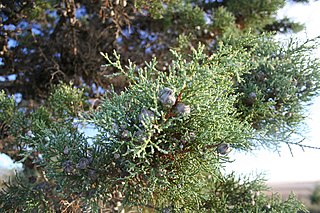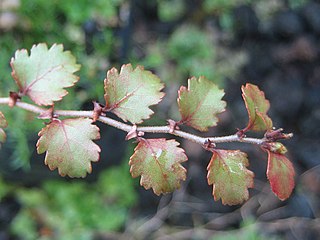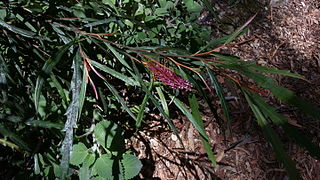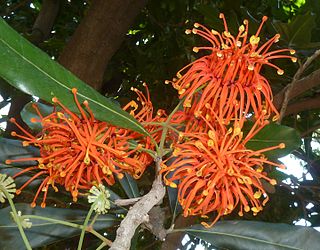Related Research Articles

Sorghum is a genus of about 25 species of flowering plants in the grass family Poaceae. Some of these species have grown as cereals for human consumption and some in pastures for animals. One species, Sorghum bicolor, was originally domesticated in Africa and has since spread throughout the globe. Seventeen of the 25 species are native to Australia, with the range of some extending to Africa, Asia, Mesoamerica, and certain islands in the Indian and Pacific Oceans. One species is grown for grain, while many others are used as fodder plants, either cultivated in warm climates worldwide or naturalized in pasture lands. Sorghum is in the subfamily Panicoideae and the tribe Andropogoneae.

Cypress is a common name for various coniferous trees or shrubs of northern temperate regions that belong to the family Cupressaceae. The word cypress is derived from Old French cipres, which was imported from Latin cypressus, the latinisation of the Greek κυπάρισσος (kyparissos).
In biology, a monotypic taxon is a taxonomic group (taxon) that contains only one immediately subordinate taxon.

The Antarctic flora is a distinct community of vascular plants which evolved millions of years ago on the supercontinent of Gondwana. It is now found on several separate areas of the Southern Hemisphere, including southern South America, southernmost Africa, New Zealand, Australia and New Caledonia. Joseph Dalton Hooker was the first to notice similarities in the flora and speculated that Antarctica had served as either a source or a transitional point, and that land masses now separated might formerly have been adjacent.

Grevillea longifolia, the fern-leaf spider flower, is a plant of the family Proteaceae, formerly known as Grevillea aspleniifolia. Commonly growing in the Sydney basin of central New South Wales, Australia Grevillea longifolia is recognizable by its deep red "toothbrush" flowers which appear in spring, and narrow, sawtoothed leaves. It is fairly readily grown in gardens.

Eidothea is a genus of two species of rainforest trees in New South Wales and Queensland, in eastern Australia, constituting part of the plant family Proteaceae. The plant family Proteaceae was named after the shape-shifting god Proteus of Greek mythology. The genus name Eidothea refers to one of the three daughters of Proteus.

Austromuellera is a genus of only two known species of medium-sized trees, constituting part of the plant family Proteaceae. They are both endemic to three restricted areas of the wet tropics rainforests of north-eastern Queensland, Australia. The genus was named in 1930 in honour of Ferdinand von Mueller by Cyril T. White. They lie within the tribe Banksieae within the family Proteaceae, their closest relatives the genera Musgravea and Banksia.

Grevillea longistyla is a large shrub of the family Proteaceae that is native to south-east Queensland in Australia. It has orange to red flowers; long, narrow leaves and grows to 3 to 4 metres in height and 2 to 3 metres in width.

Eidothea hardeniana, commonly named nightcap oak, is a species of tree, up to 40 m (130 ft) tall, of the plant family Proteaceae, which botanist Robert Kooyman recognised as a new species only recently in 2002. The species has an official listing as critically endangered on the Australian Commonwealth EPBC Act and as Endangered on the NSW Threatened Species Act. The name hardeniana honours the botanist Gwen Harden. Phylogenetics studies now suggest it represents a basal branch of the Proteoid clade of the Proteaceae.

The flora of Australia comprises a vast assemblage of plant species estimated to over 20,000 vascular and 14,000 non-vascular plants, 250,000 species of fungi and over 3,000 lichens. The flora has strong affinities with the flora of Gondwana, and below the family level has a highly endemic angiosperm flora whose diversity was shaped by the effects of continental drift and climate change since the Cretaceous. Prominent features of the Australian flora are adaptations to aridity and fire which include scleromorphy and serotiny. These adaptations are common in species from the large and well-known families Proteaceae (Banksia), Myrtaceae, and Fabaceae.

Bellendena montana, commonly known as mountain rocket, is a species of low-growing multi-stemmed shrub in the plant family Proteaceae. It is endemic to high-altitude subalpine and alpine regions in Tasmania, Australia. The prominent white flower spikes appear over summer, followed by small bright red or yellow fruit in late summer and autumn.

Stenocarpus sinuatus, known as the firewheel tree, is an Australian rainforest tree in the Proteaceae family. The range of natural distribution is in various rainforest types from the Nambucca River in New South Wales to the Atherton Tableland in tropical Queensland. Stenocarpus sinuatus is widely planted as an ornamental tree in other parts of Australia and in different parts of the world.

Orites lancifolius, commonly known as alpine orites, is a shrub in the family Proteaceae. It is endemic to south-eastern Australia. The species has a spreading habit and may be a prostrate or up to 2 metres high. The leaves are 1 to 3 cm long, and 5 to 12 mm wide. White to pale yellow flowers appear between December and January in its native range. The species was first formally described in 1855 by botanist Ferdinand von Mueller from plant material that he collected "on the rocky summits of the Australian Alps ".

Xylomelum pyriforme, commonly known as the woody pear, is a species of plant in the family Proteaceae native to eastern Australia. It grows as a large shrub or small tree to five metres high.

Adenanthos meisneri, commonly known as prostrate woollybush, is a species of shrub in the family Proteaceae. It is endemic to the south-west of Western Australia.
Grevillea patulifolia, commonly known as swamp grevillea, is a shrub species in the family Proteaceae. It is native to the states of New South Wales and Victoria in Australia.
Grevillea polybractea, commonly known as crimson grevillea, is a shrub species in the family Proteaceae. It is native to the states of New South Wales and Victoria in Australia.

Grevillea ramosissima, commonly known as fan grevillea, is a shrub species of the family Proteaceae. It is native to south-eastern Australia.
The World Checklist of Selected Plant Families is an "international collaborative programme that provides the latest peer reviewed and published opinions on the accepted scientific names and synonyms of selected plant families." Maintained by the Royal Botanic Gardens, Kew, it is available online, allowing searches for the names of families, genera and species, as well as the ability to create checklists.
Grevillea pterosperma, commonly known as desert grevillea or desert spider-flower, is a flowering plant species in the family Proteaceae, endemic to Australia.